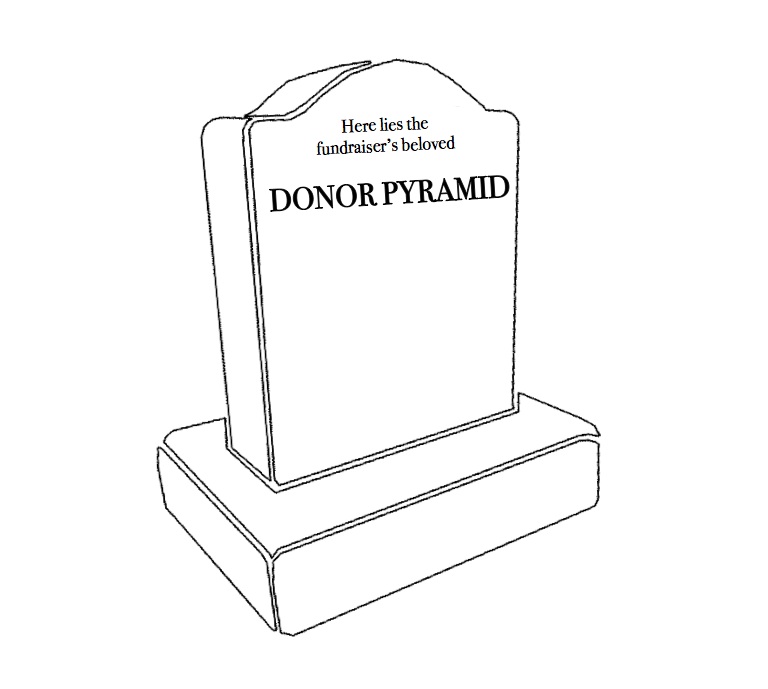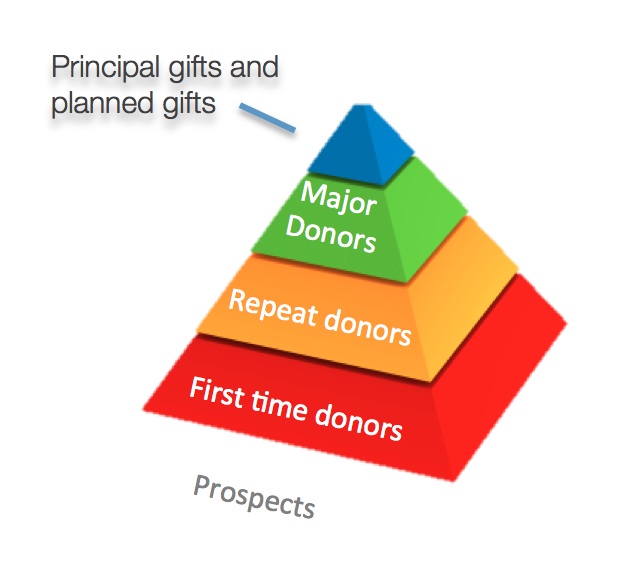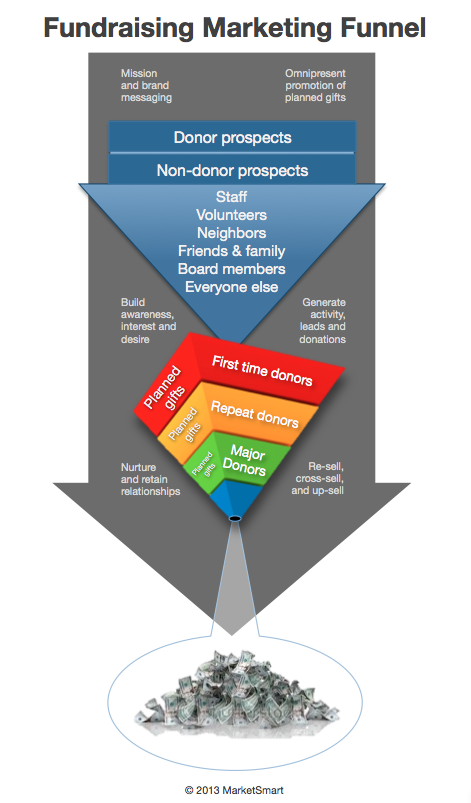We use cookies to ensure that we give you the best experience on our website. By continuing to use this site, you agree to our use of cookies in accordance with our Privacy Policy.
 Login
Login
Your Role
Challenges You Face
results
Learn
Resources
Company
The Fundraising Pyramid is Dead.



Many people don’t realize that fundraising is really just a subset of marketing. Therefore, fundraisers are marketers that raise funds.
Fundraising isn’t necessarily special. It doesn’t stand on it’s own— separate from marketing. It just requires some different strategies and tactics.
Having said that, it’s important to recognize that marketing experts don’t think in terms of pyramids. And that includes me! Instead, they think in terms of funnels. So I say it’s time to declare the fundraising pyramid dead. Let’s bury it!
Traditional fundraising pyramid below:

Why? Among many reasons, one of the biggest is because it puts planned gifts at the top of the pyramid. That doesn’t make any sense because non-donors, one-time donors, staff and volunteers can plan gifts for your organization. So why put planned gifts at the top as if it’s the final step in a long climb to the fundraising zenith? True marketers would encourage the promotion of planned gifts to everyone that comes in contact with an organization. How? With awareness, lead generation and cultivation strategies.
So if we bury the fundraising pyramid, should we replace it with something else?
Yes! I recommend using the fundraising marketing funnel found below instead.
Simply turn the pyramid upside down and put a hole at the bottom. Now it’s a more like a traditional marketing funnel. But let’s use words like “first time donors”, “repeat donors” and “major donors”. What do you think?

Get smarter with the SmartIdeas blog
Subscribe to our blog today and get actionable fundraising ideas delivered straight to your inbox!

The terms “re-sell,” “cross-sell” and “up-sell” need to be translated for the NPO world. It sound like donors are not GIVING so much as BUYING, and really, we don’t want donors believing or thinking that they “own” part of an organization. I can agree that they are “buying-in” but that’s totally different from just “buying.”
Let me start by saying it’s great that as the philanthropic landscape becomes more crowded and, consequently, more professionalized and noted by “for profit” minds that can certainly help develop new ways of thinking.
That said, your assertions demonstrate that you clearly ARE from outside the fundraising world. First, it seems that you are confused about what “planned giving” means. It’s an industry term that is a more gentile way of saying “bequest”. These are gifts where major, major donors leave whole portions of their estates to non-profits. The reason why they are at the top of the pyramid (the smallest piece) is because they happen infrequently, but when they do, they are often worth millions of dollars. I would say 99% of non-profit staff cannot “plan gifts” for an organization. Unless they happen to have one too many fully funded retirement plans that they would like to leave behind to lower the burden of inheritance tax on thier children.
The quantitative parts of the levels of the pyramid ARE an inverse proportion (e.g., you receive 90% of your dollars from your top 10% of donors, which means that you in turn receive the other 10% of your dollars from the other 90% of your donors. The pyramid helps fundraisers focus their limited resources and time on getting the greates ROI for how they–to your point–nurture and retain relationships.
The donor pyramid IS changing, but it’s important to be informed about the existing terminology and logic before “burying it” and throwing the baby out with the bath water.
Thanks Melina. I agree!
How about “garner recommitment”, “encourage reinvestment” and “attain increased reinvestment”?
Thank you Josh. Very well said! My only concern is that some organizations miss that point and are led to view fundraising as a progression. You are right that donors don’t necessarily make decisions in that way. I guess that’s what I’m trying to debunk.
Again thank you for your very thoughtful and wise comments.
Excellent observations!
Thanks Dan!
Right on target.
Tom. Thanks for adding your perspective. I agree that I certainly do add a “for-profit” perspective since, after all, nonprofits need to generate net gains in order to stay in business. Many nonprofits close their doors each year. Just look at the NY Opera (closing its doors after 70 years).
A couple of things to note:
1- I’m not exactly sure what it means to be from “outside the fundraising world”. I have raised money personally for several organizations throughout my life. My family raises money for several organizations regularly. And my firm raises money for dozens of organizations all year long (at the moment we have 76 campaigns running). I also included 2 organizations as beneficiaries of my estate and I donate regularly with monthly contributions. So, although I am not working inside a nonprofit, I feel quite “inside the fundraising world”. In fact, sometimes I think that people working inside a nonprofit would be well served to step outside to see what it’s like outside their bubble.
2- Planned giving is not my favorite term. It’s jargon. Most regular people have no idea what it means. I prefer legacy giving.
3- Most legacy gifts are left to nonprofits by regular people… not wealthy folks. The average gift (excluding million+ gifts) is around $57,000 and the mean is around $7,000. Those numbers are based on research.
4- These kinds of gifts are not as infrequent as one might think. About 10-12% of all donors will die with some sort of charitable provision.
5- Nonprofit staff can plan gifts. The most frequent way they do so is via beneficiary designation. We see it all the time in the responses we receive on behalf of our clients— nurses at hospitals, docents at museums, etc.
6- I believe you are probably correct that about 90% of your revenue will come from 10% of your donors.
7- After conducting hundreds of campaigns for our clients, we have found that just about anyone can leave a legacy gift (even non-donors). So I agree that focusing only on the top group of donors for legacy gift marketing might be a very efficient way to target large sums of money from major donors. But I also have found that massive revenues can be attained by using simple marketing techniques to inspire legacy gifts from anyone that cares about the organization’s mission.
8- Last thing, I feel the old fashioned pyramid misses the mark in many ways. There are more nonprofits in the world than ever before. Competition is increasing. Fundraising is merely a subset of marketing. It is not all that special. Fundraisers are “selling” something to donors (although they don’t like to use that term). My ideas might not be the final answers. That’s why I put these ideas “out there”. I like to hear what others think. Thanks so much for sharing your perspective. I appreciate your comments very much. It’s always nice to hear alternative views on the subject.
I think it’s important to note a couple of things:
1. Planned giving–of any sort–is a tool that donors use to bestow generosity upon the organizations they love. Period. While it’s true that a planned gift may be the last or largest gift a donor makes to an organization, it is not the apotheosis of giving our organizations should aspire to have donors ascend to. Nor is it always the last or largest. Sometimes it’s the first. Every donor situation is different, which leads me to the point that…
2. If you were to view the pyramid as a progression, your assumption may have merit. I contend this isn’t necessarily the way donors make decisions regarding their philanthropy, and is the wrong way for an organization to view the pyramid.
The organziations for whom I have worked never look at a pyramid in that manner. Rather, it’s a simple visual representation of what a typical, successful fundraising campaign will look like at the end. You will have a large number of smaller contributions at the base, a larger number of “major” contributions in the middle, and a very small number of “principal” or transformational gifts at the top.
The pyramid is nothing more or less than a visual representation of the statistical reality of the old “90/10” rule.
I am one of those who has existed in your ‘Bubble” and I want to share with you that life as a development person in a nonprofit takes real commitment. Those are the trenches. Actually, as a development officer for 30 years my primary mission is and has been to build relationships, not SELL anything. Most donors are looking for a way to fulfill a mission in their own life and I help them do it. The other area left out of the equation is without a balanced plan that includes events, annual campaigns, major gifts, grants and planned giving, you are not providing multiple options so the donor can make a choice. I would submit that there are a lot of development people out there who could fill you in on the inaccuracy of your statement. And by the way, fundraising is not a subset opf anything.
Thank you so much for your contribution to the thread Barbara.
I certainly don’t want to anger dedicated fundraisers that have done a great job building relationships over many years. Heck! I’ve done the same… built relationships with clients buying from me and with fundraisers to whom I give money to advance causes I care about.
We may be getting into semantics here though. I believe that “selling” is not a dirty word. The best sales people build relationships to procure sales just like the best fundraisers build relationships in order to procure donations. Is there really a difference between raising funds and generating revenue?
Perhaps could it be that some fundraisers simply don’t like the word “selling”. Your comment “I help them do it” is exactly what great sales people do.
Also, it’s been proven that buying and donating both release the chemical dopamine and the same parts of the brain are activated. So I’m always puzzled by the responses I hear sometimes when I use the word “selling” with some fundraisers. Feel free to shed some light on why that word irks fundraisers.
Last thing, I’ll have to respectfully disagree that fundraising is not a subset marketing for similar reasons.
Thanks again for contributing. Your opinion is truly very much appreciated.
Josh, your comments are right on. In my 30 year fundraising career I have seen too many fundraisers who treat the donor pyramid as a progression and not an illustration of the 90/10 rule. Greg, thanks for opening up this discussion. I have been expressing similar ideas locally but they have not been positively received. The donor pyramid is one of those sacred cows.
As to the idea that fundraising is a subset of marketing. Kathleen Kelly made a solid argument for this in her, “Effective Fund-Raisng Management” book published in 1998. At that time she said fundraising could not be its own profession without a good body of research. Since then fundraising research has improved but many fundraisers are still not doing their own research or paying attention to what others have done. Language and professional jargon aside, fundraising is about building relationships and facilitating donors wishes….and that is also the goal of marketing.
[…] I think what this chart implies is this: The fundraising pyramid is dead […]
Great stuff!